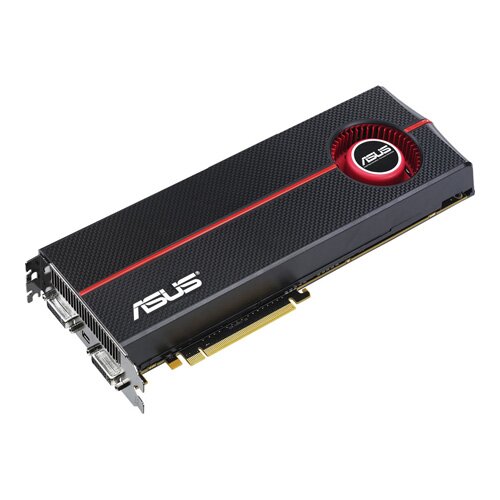Graphics cards have long had some of the faster, cooler RAM in the industry. This stands to reason, since on the consumer level these cards are typically challenged by the latest games upon arriving in the market.
It’s thanks to intense demands from the gaming segment that GDDR arose to prominence. GDDR stands for Graphics Double Date Rate, and starting the early 2000’s, GDDR2 began to take root. This effectively meant a doubling of memory performance on graphics boards – for example, a card clocked at 200MHz natively actually performed at 400Mhz via GDDR2. The RAM does this by squeezing in more data processing for each cycle of operation, or in other words both the ascent and descent sides of the cycle are used to process greater amounts of data. So if regular GDDR only had 2 bits per cycle side, GDDR2 doubled that to 4 bits.
GDDR5 emerged on the scene in the summer of 2008, but it wasn’t until fall 2009 that it appeared en masse courtesy behemoths like the ASUS Radeon HD5970 board.
Initial development by AMD/ATI, approval by computing-standards authority JEDEC and support from the likes of Samsung eventually translated into widespread acceptance. However, GDDR5 differs from GDDR2 and GDDR3 in that it’s no longer a simple matter of multiplying the base clock speed. GDDR5 does much more complex tricks than that.
While previous GDDR/graphics card combinations relied on increasing bus sizes (256-bit to 512-bit, for example) and upping the voltage supplied RAM, GDDR5 retains a modest core voltage of 1.5v and so far comes mostly in 128 and 256-bit bus varieties. It also has the same 8-bit prefetch as GDDR4, which is double what GDDR3 can pull. Prefetch means the amount of data each side of the aforementioned work cycle can process, so an 8-bit prefetch is actually 16 bits per cycle. Sounds complicated? You haven’t heard the half of it.
GDDR5 adds dual clock speed ability to the mix, in essence operating two memory clock cycles concurrently. One clock speed is double the other, so certain operations can occur in twice the processing speed – if the memory is clocked at 800MHz, for example, then the higher clock speed is 1600MHz. Naturally the faster of the two also delivers twice the data per prefetch, just in case you were thinking you had this figured out.
GDDR5 memory can sustain these more complex work models thanks to advanced error detection routines built into the circuits and controlling ROM. Errors are detected early, quarantined and then re-executed on the spot. The result is a smoother data flow, and in computing smoother means faster.
From a user standpoint, GDDR5 is important because it continues the trend towards more efficient memory that’s nonetheless more powerful. The die size is smaller on GDDR5 chips, therefore they consume less energy, even while producing more memory bandwidth per nanometer than any previous standard. Also, GDDR5 came about more or less at the same time as the new DX11, signaling another evolutionary notch in the eyes of many gamers.
We just can’t wait to try and explain GDDR6 already.


